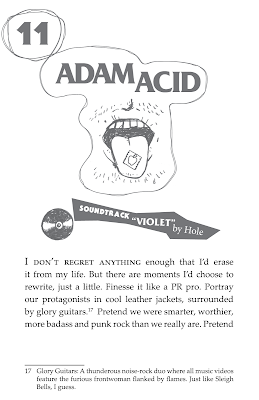I feel like starting this post with the classic Sesame Street sign-off.
This book was brought to you by the letter G.
Because how can I not, when the memoir Glory Guitars, by Gogo Germaine, is being published by University of Hell Press' Greg Gerding, with cover art by Joel Amat Güell, author photos by Glenn Ross, and interior design graced by my own Gs*? The number of Gs in that list makes me so giddy that I want to go through the entire interior of the book and count all the Gs in it. But that would be weird.
8,295.
Sesame Street is a strange reference, of course, when you're talking about a book crammed full of sex, drugs, and punk rock. University of Hell describes the book as the "memoir of a ’90s teenage punk rock grrrl." It's a power-chord-fueled joyride full of personality and wit (gee, that sounds like a blurb)—and toward the beginning of this year, Greg reached out to me about designing its interior. Now, interior design doesn't sound anywhere near as fun a project as cover design, but this one was a blast. It was way more than laying paragraphs of text down on the page. Greg wanted the interior design to match the edge and energy of the book and provided me with super fun illustrations that I could use throughout and loads of freedom for experimenting with how to use them.
The cover design was done, as I mentioned before, by Joel Amat Güell, and it's drop-dead perfect.
A lot of Joel's elements from that cover were given to me in individual, black and white form.
And Joel created special illustrations to head each chapter. Like so:
So fun, right?
One of the cool things about Glory Guitars is that it's structured around a "soundtrack." Each chapter is divided up into short sections, and each section is headed and ended with a song in this soundtrack. "Never Say Never" by Romeo Void. "Submission" by Sex Pistols. "Fun Time" by Iggy Pop. "Demirep" by Bikini Kill. The songs give flavor and a nice layer of punk history to the book but they're also nicely curated, reflecting the stories and the tones of each section. My job was to give the soundtrack its visual sense, something that would fit with the overall look of cover and interiors and evoke, of course, music. Music and edginess and, since these were breaks between sections... breakiness.
Joel made us a couple small CD illustrations in the style of the rest of his art, and I arranged things like so, referencing the way the subtitle is styled on the cover.
It was fun to be loose and scrappy with these, make them different every time. The challenge was fitting everything elegantly on the page. If the text came too far down, for example, there wasn't enough space for a soundtrack break but too much empty space left at the bottom. The added element of footnotes on some pages made this challenge even harder. Then the big challenge came in the proofing process, where small changes were being made in the book, and each tiny change could set off a chain reaction to the spacing for the rest of the chapter.
Chapter openers had the special Joel illustration, with some added styling of my own, plus a soundtrack song to start them off.
As I worked through the pages, arranging text and artwork, I found and listened to lots of the songs in Gogo's soundtrack. I don't know much punk, although I've always like the hypertensive, raw sound of it. It was fun to immerse myself in her chosen songs as I put together the interior of her book.
I won't share all the different touches, but I'll say that I extra enjoyed blinging up her author photos...
...and doing a little Glory Guitars treatment to Patti Smith's epigraph.
Glory Guitars is available for preorder in all the main places,
like Indiebound, and also
on the University of Hell Press website where you have the added bonus that you can choose from five different variant color covers. It's officially out on October 11, which is also the International Day of the Girl. A cool promo video,
is here. Here's an excerpt to let you know just what kind of punk grrrl you're dealing with:
By age fifteen, we had discovered an intricate infra-structure of debauchery across Fort Collins. Our entire network of punks and degenerates knew its secrets. We knew which liquor stores sold to minors: the cramped chunk of cement on Riverside Drive with a view of the train tracks; the more wholesome, suburban wine shop where parents might shop, yet they surprisingly didn’t ID. We knew which cafes would let underage people smoke inside: Max’s Subsonic—an old house turned café, with rooms to get lost in, that threw actual parties for underage kids—plus late nights at IHOP, and within the dingy, red-painted walls of Paris on the Poudre, the goth cafe. While I’m glad for the health of today’s youth, I almost feel bad they won’t ever experience the dirtbag tang of indoor smoking.
Teenage haunts are havens for illicit activity that are hidden in plain sight; they often have short names easily whispered in a pinch. The Ditch. The Dam. The Path. I knew the Path was a hard place the day one of the skaters shot a new girl at school with a duck gun as his friends erupted in laughter. I was horrified, but the fact that I didn’t do anything to help still haunts me.
There was the Starlite, the downtown punk club as shitty as its glittery aspirational name suggests. It hosted many of my friends’ bands, touring acts, and it even hosted an impromptu show in the parking lot featuring ALL, former members of the Descendents. Plus, the occasional party where girls wrestled in kiddie pools of Jell-O.
The memories of such parties and locations are often mysterious. I have a hazy memory of participating in Jell-O wrestling at the Starlite but can’t be sure. It happened during Corinne’s and my wrestling phase, a brief period when we couldn’t even be together without her getting an evil glint in her eye before thrashing me on whatever PBR-soaked carpet or viscid floor we were on. I have a glimpse of a memory of the Starlite, and looking down to see my white tee soaked in syrupy red. I have another piece of a memory of making out with a skater boy, Shane, in the back of a crashing car. Kitty was backing out and lodged the car into a pole.
~
*Not wanting to not give credit where it's due, the front cover photos were by the decidedly G-less Carri Lawrence.



















